标签:des style blog http color os io ar strong
Embodiments of the invention are generally directed to systems, methods, and apparatuses for linear to physical address translation with support for?page attributes. In some embodiments, a system receives an instruction to translate a memory pointer to a physical memory address for a memory location. The system may return the physical memory address and one or more?page attributes. Other embodiments are described and claimed.
Embodiments of the invention generally relate to the field of computing systems and, more particularly, to systems, methods and apparatuses for virtual address to physical address translation with support for?page?attributes.
Virtual memory allows programmers to use a larger range of memory for programs and data than is provided by the actual physical memory available to a processor. In addition virtual memory allows programs to be loaded in parallel to one another with a memory map that is impassive to the presence of other programs and the location to which it is loaded. A computing system maps a program‘s virtual addresses (also known as a Linear Address in the IA32 architecture—in this description ‘linear address‘ or LA is used synonymously with ‘virtual address‘) to real hardware storage addresses (e.g., physical memory addresses) using address translation hardware. The hardware uses a tree of tables in memory as the input data for the address translation. The root of the tree is pointed to by a register that holds the physical address of the first?table?in the?page?table?tree. An example of such a register is CR3 in the IA32 architecture.?Page?table?entries (PTEs) are addressed using a base and an index. The base is taken from a register or a previous?table?memory pointer. The index is using a portion of the linear address. The PTE includes either the?page, if the rest of the sub tree is not present in memory, or a memory pointer and other information to be discussed below. The memory pointer is for a?page?in memory that may either include data (that belongs to the application or the operating system) or another level of the?page-table. If it is the latter case, another portion of the linear address is used to index into the?table?in a scheme similar to what is described. If the address is for an application?page, the physical address is constructed by adding the remaining bits of the address (that were not used for indexing) to the?page?base address that was retrieved from the?page?table?entry. Also, some embodiments may instantiate several translation schemes (e.g., different?table?tree indexing structures) as described in a register, for the sake of simplifying this description we will consider such information part of the CR3 register, even though it may be kept in one or more other registers.
Beyond the address translation information, these tables include information such as access rights read, write or execute, presence of the data in memory, caching policy indications,?page?modified state, etc. In some cases, a?page?table may include pages of different sizes, where larger pages are pointed to in a lower level of the?page?table?tree (instead of pointing to another?page?of pointers) The size of the?page?pointed to is stored as an?attribute?in the?page table?tree (typically in the level that points to the data?page).
To retrieve the physical address, the?page-table?entries are read in a recursive manner starting from the root (CR3 in IA32) and properties of the?page?are retrieved and merged. The IA32 Programmers‘ Reference Manual (e.g., Volume 3A) provides an example of a conventional approach to retrieving physical addresses. This process requires several memory access operations and is implemented by?Page-Table?Handling hardware or uCode sequences.
Occasionally, software is required to retrieve the physical memory address. In such cases either an emulated full?table?walk or a shortened heuristic that is based on the limitations of the setup of the?table?that the operating system imposes are used.
A translation look aside buffer (TLB) is a cache that holds the result of previous translations such that successive accesses to an address (or a range of addresses) may avoid walking the data structure and can use the results of a previous translation. In many cases the address translation also checks for the operation to meet the conditions set for the memory location. Conventional address translation instructions typically return a physical memory address for a linear address provided as an operand without providing any additional information.
Embodiments of the invention are illustrated by way of example, and not by way of limitation, in the figures of the accompanying drawings in which like reference numerals refer to similar elements.
FIG. 1?is a high-level block diagram illustrating selected aspects of a computing system implemented according to an embodiment of the invention.
FIG. 2?is a block diagram illustrating selected aspects of address translation hardware, according to an embodiment of the invention.
FIG. 3?is a block diagram illustrating selected aspects of a?page?tree having extended?page?tables according to an embodiment of the invention.
FIG. 4?is a block diagram illustrating selected aspects of a?page?table?entry according to an embodiment of the invention.
FIG. 5?is a flow diagram illustrating selected aspects of a method for linear to physical address translation with support for?page?attributes according to an embodiment of the invention.
Embodiments of the invention are generally directed to systems, methods, and apparatuses for a virtual (to be referred to as linear) to physical address translation with support for?page?attributes. In some embodiments, a system receives an instruction to translate a linear memory pointer to a physical memory address for a memory location. The system may return the physical memory address and one or more?page?attributes.
FIG. 1?is a high-level block diagram illustrating selected aspects of a computing system implemented according to an embodiment of the invention. System?100includes applications?102, kernel?104, and hardware?106. Kernel?104?manages hardware?106?and provides communication between applications?102?and hardware?106. To provide fault tolerance and security, kernel?104?may operate at a higher privilege level (e.g., ring?0) than applications?102. In some embodiments, kernel?104?includes LOAD PHYSICAL ADDRESS instruction (LPA)?108. The input parameters for LPA?108?may include nearly any pointer to memory. The output parameters of LPA?108?include a physical memory address (PA) corresponding to the pointer and one or more?page?attributes. As is further described below with reference to?FIGS. 2-5, LPA?108?may support touch operations and/or virtualization technology.
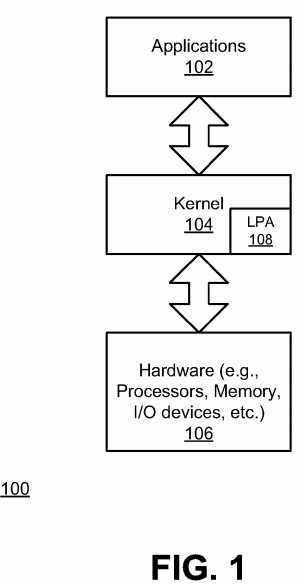
Table?1 illustrates selected aspects of an LPAxx instruction according to some embodiments of the invention. In some embodiments, the LPAxx instruction takes, as an input, a linear address (e.g., m8) and outputs the physical address of that memory location as well as one or more?page?attributes. In 32-bit modes and in cases were the physical address may be larger than the register, the instruction may have 2 registers for the address output (to support a larger than 32-bit physical address space). In 64-bit modes, a single output register may suffice. In some embodiments, the basic structure of the instruction supports read semantics. Write semantics may be supported to directly check whether a page?is write-enabled (e.g., see the trap discussion below).
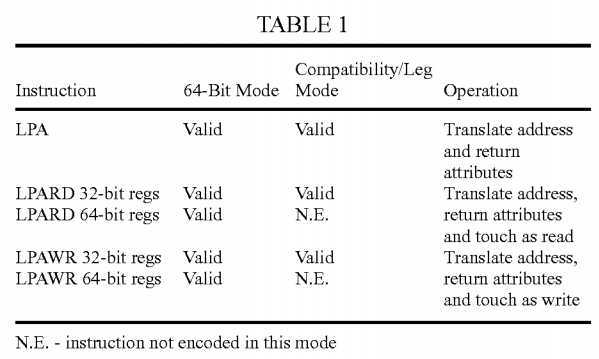
In some embodiments, when operating in a legacy mode, the LPAxx instruction moves the address of the byte address in DS:(E)SI to EDX:EAX, and EBX holds the access permissions and?page?size. In 64-bit mode, the LPAxx may move the address of the byte address in (R|E) SI to EDX:EAX (or r64 register), and EBX holds the access permissions and?page?size. In alternative embodiments, different registers may be used and different modes may be supported.
In some embodiments, the LPAxx instruction is a protected instruction that is run, for example, at the kernel level. Running the instruction at the application level can lead to a violation of the user-application virtualization effect (e.g., a user application is not aware of the actual address at which it is running). In some embodiments, the LPAxx instruction operates in synchronous operating system calls in which the kernel code operates with the user context (in IA32 mode this refers to a specific CR3 value). In alternative embodiments (as is further described below), the instruction operates in asynchronous operating system (OS) calls. In some embodiments, the use of LPAxx is similar to the equivalent SW operations that are present in the operating system, to ensure that the resulting physical address is synchronized with the?page?table.
The input parameters may be nearly any valid way of pointing to memory. For example, an m8 value or an r/m8 value may be alternatively used to give the instruction more flexibility in specifying the linear address. The address translation hardware (e.g., system?200, shown in?FIG. 2) may perform the address translation operations as if a read (or write) is required for the instruction, with a different result being returned. The address information in a translation look aside buffer (e.g., TLB?204, shown in?FIG. 2) may be used directly without going through a?page?walk phase.
In some embodiments, the output parameter is a physical address (PA) (e.g., up to 64-bits in length) and one or more?page?attributes (e.g., one or more of the attributes shown in?table?2). The PA may be stored in a single 64-bit register (e.g., when operating in the IA32e mode) or in an implicitly defined register pair (e.g., when operating in the IA32 mode or, optionally, in the IA32e compatible mode). The one or more?page?attributes may be stored in an implicitly defined register. In alternate embodiments, other means for making the data available to software for later use are used such as storing the information in a dedicated register(s) or in a memory location.
As shown in?Table?1, in some embodiments, there may be two (or more) types of LPAxx instructions. For example, some embodiments may include an LPA instruction and an LPA with touch instruction. The LPA instruction, as described above, receives, as an input, a LA and returns a PA and one or more?page attributes. The LPA with touch instruction also returns a PA and one or more page?attributes. In addition, the LPA with touch instruction determines whether the?page?is present in memory (according to the status in the last level of the page?table). If the last?page?is not present, the LPA with touch instruction produces a fault that is the same as the fault produced by a RD or a WR for LPARD and LPAWR, respectively. This allows the standard fault handlers to take care of the fault case (e.g., bring the?page?to memory in case of a?page fault or for a write touch to convert a read only?page?to a write enabled). The LPA with touch instruction determines the status of a?page?without accessing the data in memory, which saves an access to the memory hierarchy and in many cases a cache miss. Instead, the status determination is based on the status of the?page?table?entries (PTEs).
FIG. 2?is a block diagram illustrating selected aspects of address translation hardware, according to an embodiment of the invention. Address translation hardware?200?includes memory request unit (MRU)?202, translation look aside buffer (TLB)?204,?page?miss handler (PMH)?206, memory sub system (MSU)208, physical address return register (PARR)?210, and multiplexer (MUX)?212. In alternative embodiments, address translation hardware?200?includes more elements, fewer elements, and/or different elements.
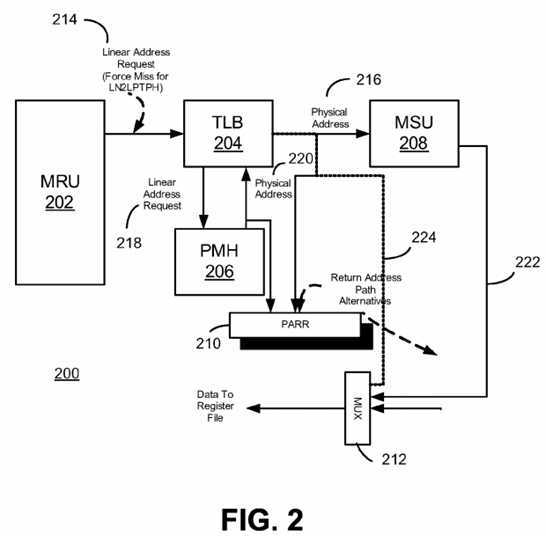
MRU?202?issues memory requests (e.g., either a load or store) that include a linear address (e.g., linear address?214). TLB204?is a caching mechanism (which may include multiple layers of TLBs) that holds the physical address and attributes of linear addresses that that have already been translated. Not all previously translated addresses are held in the TLB and various caching heuristics are applied to determine which addresses are kept. When the?Page?Tables are updated the affected entries are purged from the TLB either by direct software control (software managed TLB coherency) or by hardware (hardware managed TLB coherency). If the translation for LA?214?is found in the TLB?204?the TLB outputs the physical memory address (PA) directly. The PA (e.g., PA?216) can be used to obtain data directly from MSU?208. If TLB204?does not include the address, then the LA is sent (218) to PMH?206. PMH?206?performs a?page?walk, and if the?page walk is successfully completed returns the PA (220) to TLB?204. When the PMH walk fails (e.g., the data is not present in memory for any level of the?page?table) an exception is generated which yields to the operating system. For LPA operation in some embodiments the operation terminates with status that indicates where the fault occurred without generating an exception, more details on the returned information are provided below. The MSU?208?represents the memory hierarchy which may consist of directly accessing the memory or one or more levels of caches used to reduce memory access delays. The MSU?208?returns the data stored in Physical Address?216?via a return bus to a data registers (222).
In some embodiments, in addition to obtaining the PA (from either TLB?204?or PMH?206, depending on the case), one or more?page?attributes are obtained in response to the instruction. The PA and the associated?page?attributes are returned as part of the LPA parameters to the processor registers. In some embodiments, the PA and the associated?page?attributes are placed in a physical address return register (e.g., PARR?210) which is a register dedicated for the holding of the PA and/or attributes information and a status that indicates the completion of the operation. Optionally the processor may use microcode to read the data from the PARR and place it into a general purpose register. In an alternative embodiment, the PARR can be directly addressed by other processor instructions. In another alternative embodiment, the PA and associated page?attributes may be returned to the processor via a read return bus (e.g.,?224). In yet other embodiments, different techniques may be used to return the PA and associated?page?attributes to the processor.
Table?2 provides a list of selected?page?attributes that may be returned, with a PA, in some embodiments of the invention. In alternative embodiments, more attributes, fewer attributes, and/or different attributes may be returned.
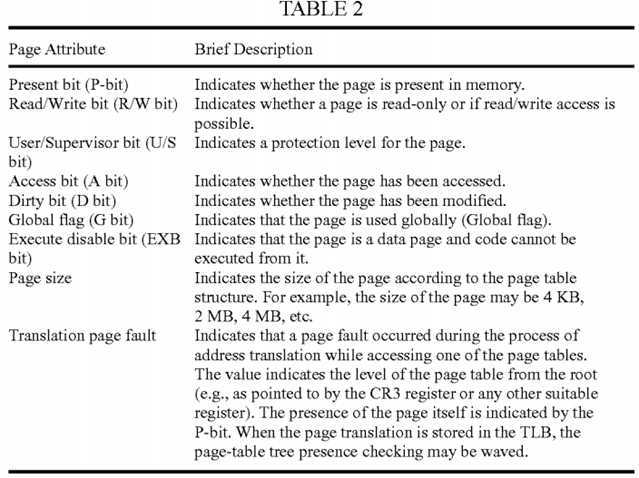
For most cases, the exceptions are handled in substantially the same way as they are for a normal memory access (read or write). In some embodiments, however, the following exceptions apply. If the LPAxx fails to access a data?page, the instruction returns an address that is equal to zero and the P-bit is cleared. If the address translation fails to access any of the?page?tables, the "Translation?Page?Fault" status is set to indicate the fault and the level of the fault. Regarding the LPAxx with touch instruction, the?page?fault is taken if the access to the?page?fails (e.g., generating a?page?fault exception). In some embodiments, the exception is not taken if the failure is on any of the?page?tables‘ access which is flagged using the "translation?Page?Fault" status.
In some embodiments, the LPAxx instruction supports virtualization technology (VT) with enhanced?page?table?(EPT). When operating in a VT environment, the translation of an address may depend, in part, on whether the requestor is a guest OS or the host OS (or virtual machine manager—VMM), as indicated by status bits within the processor. In some embodiments, if the requester is the host OS, then the LPAxx instruction returns the host PA (HPA). If, however, the requester is the guest OS, then the LPAxx instruction may return the guest PA (GPA).?FIG. 3?is a block diagram illustrating selected aspects of address translation in a VT environment, according to an embodiment of the invention.
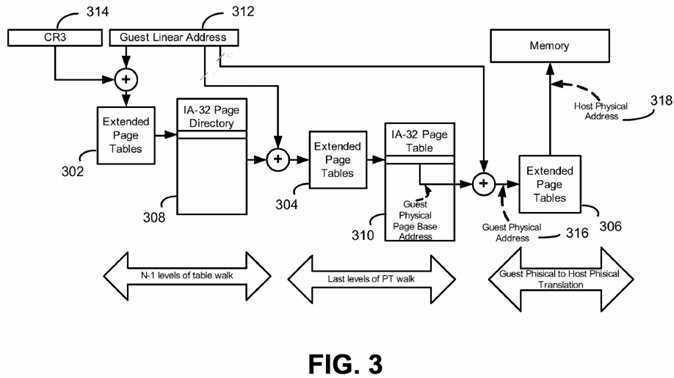
Page?table?tree?300?includes extended?page?tables (EPTs)?302-306. EPTs?302-306?are similar to the conventional tables (e.g.,?308?and?310), except that EPTs?302-306?belong to the host OS. The EPT uses a tree of tables pointed to by an EPT base register to translate a GPA into a HPA. This operation is performed for any GPA that requires translation including access to the guest?page?tables as part of the guest?page?table?walk. A portion of guest LA (GLA)?312?and the CR3 (314) reference a location in EPT?302. EPT?302, in turn, points to a location in?page?directory?308.?Page?directory?308?and another portion of GLA?312?may be used to reference a location in EPT?304. This process may be continued for nearly any number of levels until GPA?316?is reached. EPT?306?maps GPA?316?to HPA?318. In some embodiments, when operating in a VT environment, the LPAxx instruction returns the GPA of the?page?itself as stored in the last guest?page?table?(e.g., GPA316) and one or more associated?page?attributes.
In some embodiments the TLB holds only the HPA, which requires the?page?table?to be walked for returning the GPA, as done for the case of a TLB miss. In alternate embodiments, the TLB includes an additional field that holds the GPA and attributes of the?page?which enables retrieving the GPA from the TLB.
FIG. 4?is a block diagram illustrating selected aspects of a?page?table?entry (PTE) according to an embodiment of the invention. In some embodiments, the output parameters of an LPAxx instruction are obtained from a PTE (e.g., PTE?400) or a similar entry in a TLB (e.g., TLB?204). For example, the PA address may be obtained from field?402?and the associated page?attributes may be obtained from fields?404-420. The?page?attributes shown in fields?404-420?are discussed above in Table?2. In alternative embodiments, PTE?400?may include more fields, fewer fields, and/or different fields.

FIG. 5?is a flow diagram illustrating selected aspects of a method for linear to physical address translation with support for page?attributes according to an embodiment of the invention. Referring to process block?502, address translation logic (e.g., address translation logic?200, shown in?FIG. 2) receives an instruction (e.g., an LPAxx instruction) to translate a memory pointer (e.g., a LA) to a PA. The address translation logic translates the memory pointer to a PA without performing a memory access. Instead, the output parameters are obtained either from TLB entries or from PTEs. Referring to process block?506, the PA and one or more associated?page?attributes are returned to the processor (e.g., by placing the data in a PARR or returning the data via a read return bus). The phrase "without performing a memory access" refers to relying on page?table?information to perform the translation. The?page?table?information may be provided by a?page?table?entry (e.g., in the TLB) or from memory.
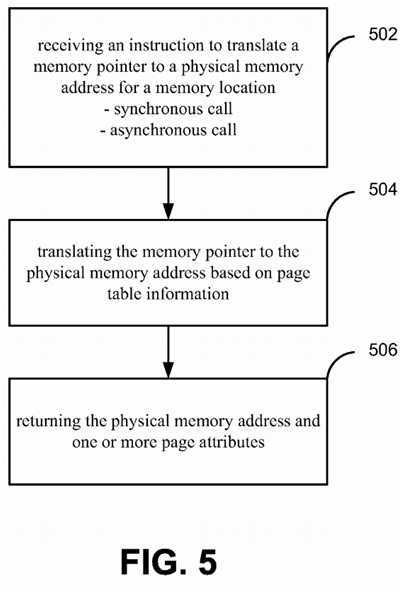
In some embodiments, the LPAxx instruction supports asynchronous calls in addition to synchronous calls. An asynchronous call refers to a call to the LPAxx instruction from an application that does not correspond to the current CR3 that is being used for translation. In some embodiments, the LPAxx instruction includes additional parameters that tell the?page?tree where to start the?page?table?walk (e.g., a CR3 value corresponding to the application that made the asynchronous call). In many cases, the data in the TLB cannot be used during the asynchronous call since that data corresponds to a different program. Thus, in many cases, a?page?table?walk is executed to obtain the PA and the one or more associated?pageattributes. In other cases, tags are provided to identify with which address space (CR3) a TLB entry is associated. This may enable usage of TLB entrees in asynchronous calls.
SRC=https://www.google.com.hk/patents/US20080301398
Linear to physical address translation with support for page attributes
标签:des style blog http color os io ar strong
原文地址:http://www.cnblogs.com/coryxie/p/3961609.html